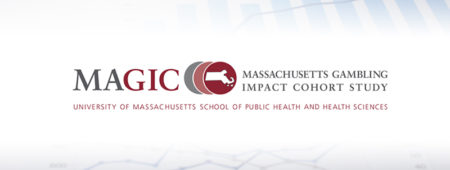Research Update: UMass Amherst Team Reports Gambling Research Results to Massachusetts Gaming Commission
- January 10, 2018
- by MGC Communications
- 0 comments

First Major Cohort Study of Adult Gambling in the United States
AMHERST, Mass. – Results of a baseline study on gambling behavior in Massachusetts that establishes how people participated – or not – in gambling prior to the opening of any casinos were reported today to the Massachusetts Gaming Commission (MGC) by epidemiologist Rachel Volberg and colleagues at the University of Massachusetts Amherst’s School of Public Health and Health Sciences. This is the first major cohort study of adult gambling to be carried out in the United States.
Volberg and colleagues were selected by the MGC in 2013 to conduct a first-of-its-kind, comprehensive, multi-year study on economic and social impacts of introducing casino gambling in the state. The Social and Economic Impacts of Gambling in Massachusetts (SEIGMA) team is examining an array of social and economic effects.
As part of MGC’s robust research agenda, today’s results are from the separate Massachusetts Gambling Impact Cohort (MAGIC) study of factors critical to developing strategic and data-driven problem gambling services. Cohort studies survey the same individuals over time and provide information on how gambling and problem gambling develops, progresses and how individuals may experience remission. “This has significant value as it can highlight risk and protective factors important in developing effective prevention, intervention, treatment, and recovery support services,” Volberg notes.
Today’s report is based on analyses of 3,096 Massachusetts residents who completed the SEIGMA baseline study of self-reported past-year gambling behaviors in Wave 1 in 2013/2014 and Wave 2 in 2015. The researchers observed a statistically significant increase in overall gambling participation as well as in participation in casino gambling and horse race betting within the cohort between Wave 1 and Wave 2. They also report a statistically significant increase in the cohort in the average number of gambling formats engaged in over the previous 12 months. However, in all cases this increase was “quite small,” they note, between 2 and 3.2 percent.
Prior to beginning this research, Volberg predicted that the state’s sweeping research initiative would change the intellectual landscape and knowledge base about gambling, and she says results released today support that view. “This tells us new things, but it is nuanced,” she notes. “Based on this new study, researchers will think about gambling behavior in new ways.”
One interesting finding is “the apparent ease with which people move in and out of problem gambling status within a given year,” the lead author points out. “It’s pretty clear that people phase in and out of the problem gambling group. This movement is different than the way problem gambling has been characterized in the past. Until recently, the general orientation has been that disordered gambling is an unremitting chronic condition.” According to the report, only 49.4 percent of individuals who were Problem or Pathological Gamblers in Wave 1 were in this same category in Wave 2, with sizeable portions transitioning into At-Risk Gambling and Recreational Gambling. At-Risk Gamblers were the most unstable members of the cohort, with only 37.5 percent being in the same category in both waves. Most of these individuals transitioned to Recreational Gambling, but a significant minority transitioned to become Problem or Pathological Gamblers.
Volberg adds, “We’ve seen this movement in studies done in other jurisdictions, but this will be news to some researchers who are used to thinking of problem gambling as a progressive and chronic disorder.”
MGC Research and Responsible Gaming Director Mark Vander Linden states, “There is great value for the MGC and our public health partners in knowing the movement of people into and out of problem gambling because this data has public health implications for identifying and supporting the spectrum of services that will be most useful in preventing and treating problem gambling.”
An important aspect of all physical and mental disorders is incidence, Volberg says. That is the proportion of a population that newly develops a condition over a specified period of time.
The study reported today found problem gambling incidence in Massachusetts, at 2.4 percent, to be high compared to studies elsewhere. The authors point out, however, that those other studies have different “gambling landscapes,” used different measures of problem gambling and had shorter follow-up periods.
The report notes that the cause of the high incidence rate is unclear given that there was no significant change in the actual availability of legal gambling opportunities in Massachusetts during this time period. Researchers suggest that post-casino cohort survey data will shed additional light on the incidence rate in Massachusetts.
In addition to Volberg and colleagues at UMass Amherst, co-investigator Robert J. Williams of the University of Lethbridge, Alberta, Canada, provided oversight of study design and implementation as well as help with data analysis and reporting. Future analyses will focus on predictors of problem gambling onset and whether there are gender differences in these predictors as well as predictors of problem gambling remission and the extent to which accessing treatment is one of these factors.
Link to SEIGMA blog post: https://www.umass.edu/seigma/blog/seigma-releases-findings-first-major-cohort-study-gambling-us-massachusetts-gambling-impact
Link to MGC site and report: https://massgaming.com/wp-content/uploads/MAGIC-Wave-2-Report-1-10-18.pdf
Contact: Janet Lathrop, 413.545.0444; jlathrop@umass.edu
Rachel Volberg, rvolberg@schoolph.umass.edu
Elaine Driscoll, 617.571.2964; Elaine.Driscoll@state.ma.us